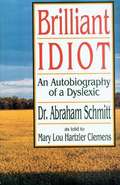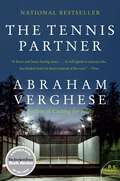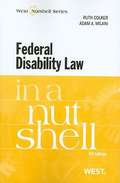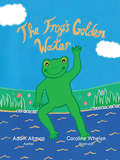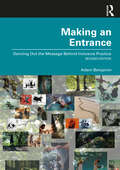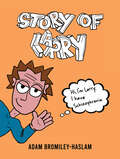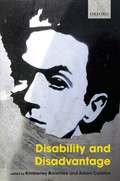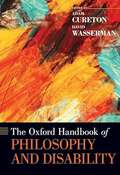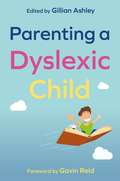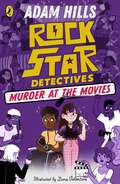- Table View
- List View
Brilliant Idiot: An Autobiography of a Dyslexic
by Abraham Schmitt Mary Lou Hartzler ClemensThis book chronicles one man's battle to earn respect and an education, only to discover in mid-life that his severe mental "fog" was a serious learning disability.
The Tennis Partner: A Doctor's Story of Friendship and Loss
by Abraham VergheseAn unforgettable, illuminating story of how men live and how they survive, from Abraham Verghese, the acclaimed New York Times bestselling author of Cutting for Stone and The Covenant of Water, an Oprah's Book Club Pick.“Heartbreaking. . . . Indelible and haunting, [The Tennis Partner] is an elegy to friendship found, and an ode to a good friend lost.”—The Boston GlobeWhen Abraham Verghese, a physician whose marriage is unraveling, relocates to El Paso, Texas, he hopes to make a fresh start as a staff member at the county hospital. There he meets David Smith, a medical student recovering from drug addiction, and the two men begin a tennis ritual that allows them to shed their inhibitions and find security in the sport they love and with each other. This friendship between doctor and intern grows increasingly rich and complex, more intimate than two men usually allow. Just when it seems nothing can go wrong, the dark beast from David’s past emerges once again—and almost everything Verghese has come to trust and believe in is threatened as David spirals out of control.
Magnets and Ladders: Fall/Winter 2011-2012
by Active Voices of Writers with DisabilitiesMagnets and Ladders is an online literary magazine that features poems, short stories, memoirs, and personal essays by writers with disabilities. The magazine is divided into sections that reflect the content of selections and voice of the authors. Topics include: life events, memoir, science fiction, nature, current issues, music, art, travel, and the craft of writing. Stories and poems about holidays and the season are also featured. Although the authors published in Magnets and Ladders have disabilities, most of their writing is not about disability. These authors have had a multitude of enriching experiences and they are proud to share them with you. www.behindoureyes.org
Magnets and Ladders: Fall/Winter 2012-2013
by Active Voices of Writers with DisabilitiesMagnets and Ladders is an online literary magazine that features poems, short stories, memoirs, and personal essays by writers with disabilities. The magazine is divided into sections that reflect the content of selections and voice of the authors. Topics include: life events, memoir, science fiction, nature, current issues, music, art, travel, and the craft of writing. Stories and poems about holidays and the season are also featured. Although the authors published in Magnets and Ladders have disabilities, most of their writing is not about disability. These authors have had a multitude of enriching experiences and they are proud to share them with you.
Magnets and Ladders: Fall/Winter 2013-2014
by Active Voices of Writers with DisabilitiesMagnets and Ladders is an online literary magazine that features poems, short stories, memoirs, and personal essays by writers with disabilities. The magazine is divided into sections that reflect the content of selections and voice of the authors. Topics include: life events, memoir, science fiction, nature, current issues, music, art, travel, and the craft of writing. Stories and poems about holidays and the season are also featured. Although the authors published in Magnets and Ladders have disabilities, most of their writing is not about disability. These authors have had a multitude of enriching experiences and they are proud to share them with you.
Magnets and Ladders: Fall/Winter 2014-2015
by Active Voices of Writers with DisabilitiesMagnets and Ladders is an online literary magazine that features poems, short stories, memoirs, and personal essays by writers with disabilities. The magazine is divided into sections that reflect the content of selections and voice of the authors. Topics include: life events, memoir, science fiction, nature, current issues, music, art, travel, and the craft of writing. Stories and poems about holidays and the season are also featured. Although the authors published in Magnets and Ladders have disabilities, most of their writing is not about disability. These authors have had a multitude of enriching experiences and they are proud to share them with you.
Magnets and Ladders: Fall/Winter 2015-2016
by Active Voices of Writers with DisabilitiesMagnets and Ladders is an online literary magazine that features poems, short stories, memoirs, and personal essays by writers with disabilities. The magazine is divided into sections that reflect the content of selections and voice of the authors. Topics include: life events, memoir, science fiction, nature, current issues, music, art, travel, and the craft of writing. Stories and poems about holidays and the season are also featured. Although the authors published in Magnets and Ladders have disabilities, most of their writing is not about disability. These authors have had a multitude of enriching experiences and they are proud to share them with you.
Magnets and Ladders: Fall/Winter 2016-2017
by Active Voices of Writers with DisabilitiesMagnets and Ladders is an online literary magazine that features poems, short stories, memoirs, and personal essays by writers with disabilities. The magazine is divided into sections that reflect the content of selections and voice of the authors. Topics include: life events, memoir, science fiction, nature, current issues, music, art, travel, and the craft of writing. Stories and poems about holidays and the season are also featured. Although the authors published in Magnets and Ladders have disabilities, most of their writing is not about disability. These authors have had a multitude of enriching experiences and they are proud to share them with you.
Magnets and Ladders: Spring/Summer 2012
by Active Voices of Writers with DisabilitiesMagnets and Ladders is an online literary magazine that features poems, short stories, memoirs, and personal essays by writers with disabilities. The magazine is divided into sections that reflect the content of selections and voice of the authors. Topics include: life events, memoir, science fiction, nature, current issues, music, art, travel, and the craft of writing. Stories and poems about holidays and the season are also featured. Although the authors published in Magnets and Ladders have disabilities, most of their writing is not about disability. These authors have had a multitude of enriching experiences and they are proud to share them with you.
Magnets and Ladders: Spring/Summer 2013
by Active Voices of Writers with DisabilitiesMagnets and Ladders is an online literary magazine that features poems, short stories, memoirs, and personal essays by writers with disabilities. The magazine is divided into sections that reflect the content of selections and voice of the authors. Topics include: life events, memoir, science fiction, nature, current issues, music, art, travel, and the craft of writing. Stories and poems about holidays and the season are also featured. Although the authors published in Magnets and Ladders have disabilities, most of their writing is not about disability. These authors have had a multitude of enriching experiences and they are proud to share them with you.
Magnets and Ladders: Spring/Summer 2014
by Active Voices of Writers with DisabilitiesMagnets and Ladders is an online literary magazine that features poems, short stories, memoirs, and personal essays by writers with disabilities. The magazine is divided into sections that reflect the content of selections and voice of the authors. Topics include: life events, memoir, science fiction, nature, current issues, music, art, travel, and the craft of writing. Stories and poems about holidays and the season are also featured. Although the authors published in Magnets and Ladders have disabilities, most of their writing is not about disability. These authors have had a multitude of enriching experiences and they are proud to share them with you.
Magnets and Ladders: Spring/Summer 2015
by Active Voices of Writers with DisabilitiesMagnets and Ladders is an online literary magazine that features poems, short stories, memoirs, and personal essays by writers with disabilities. The magazine is divided into sections that reflect the content of selections and voice of the authors. Topics include: life events, memoir, science fiction, nature, current issues, music, art, travel, and the craft of writing. Stories and poems about holidays and the season are also featured. Although the authors published in Magnets and Ladders have disabilities, most of their writing is not about disability. These authors have had a multitude of enriching experiences and they are proud to share them with you.
Magnets and Ladders: Spring/Summer 2016
by Active Voices of Writers with DisabilitiesMagnets and Ladders is an online literary magazine that features poems, short stories, memoirs, and personal essays by writers with disabilities. The magazine is divided into sections that reflect the content of selections and voice of the authors. Topics include: life events, memoir, science fiction, nature, current issues, music, art, travel, and the craft of writing. Stories and poems about holidays and the season are also featured. Although the authors published in Magnets and Ladders have disabilities, most of their writing is not about disability. These authors have had a multitude of enriching experiences and they are proud to share them with you.
Magnets and Ladders: Spring/Summer 2017
by Active Voices of Writers with DisabilitiesMagnets and Ladders is an online literary magazine that features poems, short stories, memoirs, and personal essays by writers with disabilities. The magazine is divided into sections that reflect the content of selections and voice of the authors. Topics include: life events, memoir, science fiction, nature, current issues, music, art, travel, and the craft of writing. Stories and poems about holidays and the season are also featured. Although the authors published in Magnets and Ladders have disabilities, most of their writing is not about disability. These authors have had a multitude of enriching experiences and they are proud to share them with you.
A Cane In Her hand
by Ada B. LitchfieldVal who had had O.K. vision before one day had trouble seeing. After visiting the doctors, and trying to see, she was taught how to use a cane by her teacher.
Federal Disability Law in a Nutshell (4th Edition)
by Ruth Colker Adam A. MilaniThis Nutshell presents an overview of the major federal disability laws with emphasis on the statutes, regulations, and significant points of substantive and procedural law. The fourth edition includes significant focus on the American with Disabilities Act (ADA), including its 2008 Amendment. Features coverage on constitutional rights; the definition of "disabled"; Rehabilitation Act of 1973; employment discrimination; programs and services; and housing, education, and transportation. Also reviews the many relevant areas of the Individuals with Disabilities Education Act (IDEA), including the 2004 Amendments.
The Frog’s Golden Water
by Adam Altman Caroline WhelanSkippy has enjoyed swimming in the pond's golden water his entire life. But now the golden sparkle has disappeared, so Skippy and his friends must find out what happened and return to pond to its former splendor. Come join Skippy on his adventure of discovery in his charming story.
Reproductive Endocrinology for the MRCOG and Beyond
by Adam Balen Jenny HighamUnderstanding endocrinology is central to understanding the key processes that affect normal reproductive function, while an understanding of normal endocrinology and the pathophysiology of endocrine disorders is important when dealing with reproductive disorders. This book provides a comprehensive background for all gynaecologists, covering: sexual differentiation and intersex disorders; adrenal disorders; normal puberty and adolescence; abnormal puberty; the menstrual cycle; disorders of menstruation; amenorrhoea; polycystic ovary syndrome; anovulatory fertility and ovulation induction; lactation and lactational amenorrhoea; hyperprolactinaemia; thyroid disease; diabetes; lipid metabolism and lipoprotein transport; premature ovarian failure; and calcium metabolism and its disorders. The book is primarily designed to provide a comprehensive summary for candidates preparing for the Part 2 MRCOG examination, and as such covers the RCOG curriculum for reproductive endocrinology. It is also a valuable guide for all healthcare professionals working in the field, including trainees, consultants and any health professional coming into contact with women.
Making an Entrance: Dancing Out the Message Behind Inclusive Practice
by Adam BenjaminThis second edition of Making an Entrance is a practical and thought-provoking introduction to teaching dance with disabled and non-disabled students, updated with expanded coverage, new and revised exercises, and chapters that cover post-pandemic and online practice, diversity and inclusivity. With improvisation as his central concern Benjamin covers an extensive range of topics, including new autoethnographic writing, mental health, performance, feedback, and The Dancers’ Forest, and interrogates what we mean when we talk about ‘inclusive’ and ‘integrated dance.’ There are over 50 stimulating and challenging exercises purposefully designed for dance students of all levels accompanied by teaching notes, and examples drawn from the author’s experience as a teacher, performer, and dance maker. Useful hints are provided on the practicalities of setting up workshops covering issues such as class sizes, the safety aspects of wheelchairs and accessibility. An essential read for both students and teachers of improvisation who are seeking ways to engage with issues of diversity, written to be accessible whilst offering areas of increasing complexity and challenge for more experienced practitioners.
Story of Larry
by Adam Bromiley-HaslamBeneath the veneer of simplicity lies a profound exploration of the mind’s deepest quandaries. Journey with me through relentless internal battles, where the only opponent is oneself. Confront the pervasive dread of solitude and the challenges of discerning reality from illusion. If these pages resonate with even a single reader, every struggle shared will have been worth the journey. Discover a narrative that seeks connection in our shared human experience.
Sociolinguistics and Deaf Communities
by Ceil Lucas Adam C. SchembriHow do people use sign languages in different situations around the world? How are sign languages distributed globally? What happens when they come in contact with spoken and written languages? These and other questions are explored in this new introduction to the sociolinguistics of sign languages and deaf communities. An international team brings insights and data from a wide range of sign languages, from the USA, Canada, England, Spain, Brazil and Australia. Topics covered include multilingualism in the global deaf community, sociolinguistic variation and change in sign languages, bilingualism and language contact between signed and spoken languages, attitudes towards sign languages, sign language planning and policy, and sign language discourse. Sociolinguistics and Deaf Communities will be welcomed by students of sign language and interpreting, teachers of sign language, and students and academics working in linguistics.
Disability and Disadvantage
by Kimberley Brownlee Adam CuretonThis book offers a much-needed investigation of moral and political issues concerning disability, and explores how the experiences of people with disabilities can lead to reconsideration of prominent positions on normative issues. Thirteen new essays examine such topics as the concept of disability, the conditions of justice, the nature of autonomy, health care distribution, and reproductive choices. The contributors are Norman Daniels, Ellen Daniels Zide, Leslie P. Francis, Christie Hartley, Richard Hull, Guy Kahane, F. M. Kamm, Rosalind McDougall, Jeff McMahan, Douglas MacLean,Susannah Rose, Anita Silvers, Julian Savulescu, Lorella Terzi, David Wasserman, and Jonathan Wolff.
The Oxford Handbook of Philosophy and Disability
by David Wasserman Adam CuretonDisability raises profound and fundamental issues: questions about human embodiment and well-being; dignity, respect, justice and equality; personal and social identity. It raises pressing questions for educational, health, reproductive, and technology policy, and confronts the scope and direction of the human and civil rights movements. Yet it is only recently that disability has become the subject of the sustained and rigorous philosophical inquiry that it deserves. <P><P> The Oxford Handbook of Philosophy and Disability is the first comprehensive volume on the subject. The volume's contents range from debates over the definition of disability to the challenges posed by disability for justice and dignity; from the relevance of disability for respect, other interpersonal attitudes, and intimate relationships to its significance for health policy, biotechnology, and human enhancement; from the ways that disability scholarship can enrich moral and political philosophy, to the importance of physical and intellectual disabilities for the philosophy of mind and action. The contributions reflect the variety of areas of expertise, intellectual orientations, and personal backgrounds of their authors. Some are founding philosophers of disability; others are promising new scholars; still others are leading philosophers from other areas writing on disability for the first time. Many have disabilities themselves. This volume boldly explores neglected issues, offers fresh perspectives on familiar ones, and ultimately expands philosophy's boundaries. More than merely presenting an overview of existing work, this Handbook will chart the growth and direction of a vital and burgeoning field for years to come.
Parenting a Dyslexic Child
by Helen Ross Lindsay Peer Pennie Aston Adam Gordon Katrina CochraneDrawing on the expert knowledge and research gathered by the British Dyslexia Association, this is a complete guide to parenting a child with dyslexia. Covering assessment, diagnosis, home and school support, emotional development and more, this empowering book has everything you need to help your child reach their full potential.With accessible guidance on reading, writing, spelling, organisation and study skills, this book will also help you to build self-belief in your child whilst ensuring that you care for yourself along the way. This book provides clear information on how dyslexia affects children and families at all stages of life, with insights on communicating with schools and ensuring the best support in all environments.
Rockstar Detectives: Murder at the Movies (Rockstar Detectives #2)
by Adam HillsThe brilliant and laugh-out-loud second mystery from comedian Adam Hills featuring a young detective dream team. The perfect read for fans of Sharna Jackson, Robin Stevens and David Baddiel!Meet Charley - a totally ordinary 13-year-old, who's also an international singing sensation.Meet George - Charley's best friend, social media whizz, and budding comedian.Charley and George are in Sydney, where Charley is filming her first movie. But when mysterious accidents begin to happen whenever Charley's on set, the duo suspect someone isn't as excited about her big screen debut as they are . . .No one else seems to believe that Charley's in real danger and anyone - from the bad-tempered director to Charley's rude co-star - could be a suspect. Can the detective dream team solve their second mystery, wrap the movie - and keep Charley in one piece?The fabulously funny new novel from award-winning comedian and author of ROCKSTAR DETECTIVES, Adam Hills.Praise for the first book in the ROCKSTAR DETECTIVES series:'A delightfully funny book with a big, big heart' - David O'Doherty'Fast-moving, lively, full of jokes and humour and with a satisfying puzzle to be solved, this makes for perfect escapist reading' - LoveReading4Kids
